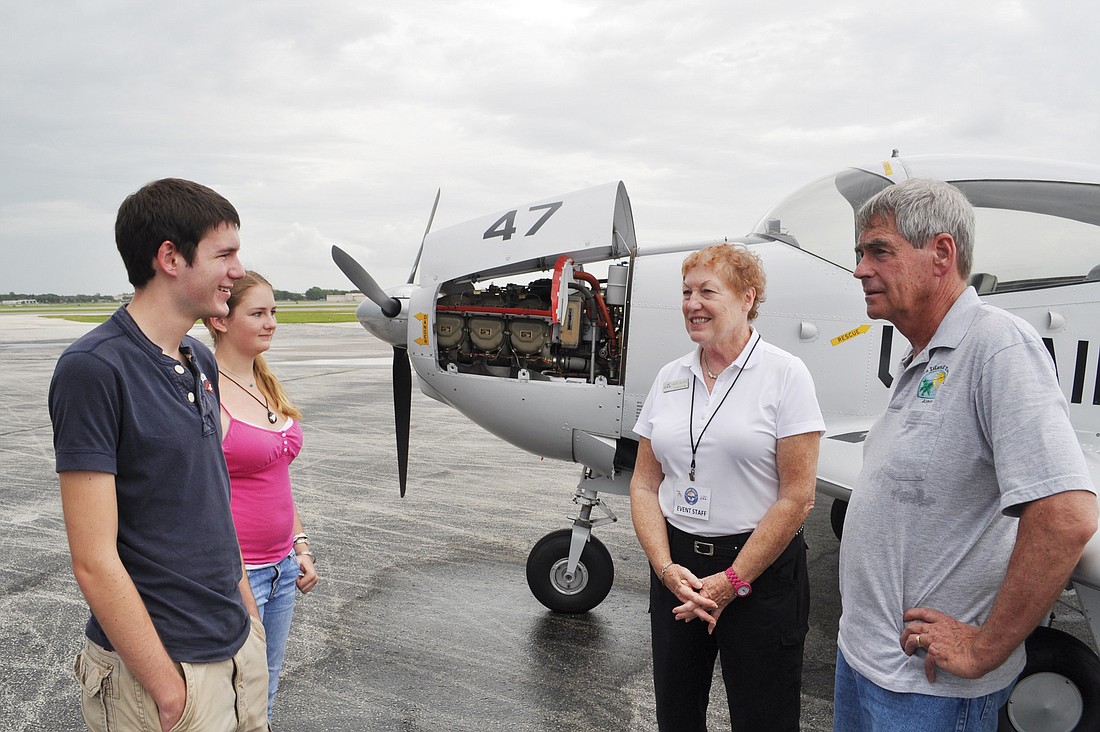- April 23, 2024
-
-
Loading

Loading

As Dan Smith’s single-engine, 1947 Navion touched down on the runway and taxied to the back door of Dolphin Aviation, the smiles of the siblings inside were telling signs of the flight they had just experienced.
Brian and Jen Becker, along with dozens of other future pilots, airplane enthusiasts and adventurous spirits, had just completed their first flight as part of Young Eagles, a program that pairs budding aviators with experienced pilots to offer free flights to children and encourage their involvement in aviation.
After climbing out of the plane’s hatch, Brian Becker stood and chatted with his sister and the pilot about their experience.
“It was awesome,” said Becker, a high-school senior, who plans to attend the U.S. Naval Academy to study aviation. “It was a great learning experience.”
The flight was made even more memorable by the fact that it was hosted by the local chapter of the Experimental Aircraft Association, which was also celebrating its 60th anniversary.
Originally founded in 1952, EAA Chapter 180 offers free programs to children in the Sarasota and Bradenton area on a monthly basis, including free flights, build-a-plane workshops and flight-safety seminars. The chapter has a membership of about 120 members.
“We want to unite the general aviation community and preserve the history of aviation, as well as its future,” said EAA Chapter 180 Vice President Matt Greg. “We want to inspire people to become interested in aviation fields of work, whether it’s recreationally or professionally.”
To celebrate the 60th anniversary of the chapter, which has flown more than 3,700 flights since the program’s inception, 35 children showed up to Dolphin Aviation to earn their Young Eagle certifications and take to the skies with volunteer pilots.
The Young Eagles took a tour of Dolphin Aviation, where they watched an informational video, explored a flight simulator and watched as pilots checked radar screens for weather conditions before heading out in small groups for takeoff.
The program is run on a completely volunteer basis, and many retired servicemen and women volunteer their time and aircrafts to inspire young people to fly. Gregg estimates that the cost of fuel alone for these small aircraft is nearly $60 per hour, and that doesn’t factor in other costs, such as maintenance. He says they do it for the love of flying.
Volunteer pilot Dan Smith has been flying Young Eagles for approximately 20 years, and he says he enjoys sharing his love of aviation with a younger generation.
“I could be doing this, or I could be home cutting the grass,” joked Smith. “I have a real blessing here, being able to indoctrinate these young people with what’s out there other than video games.”
Capt. Dan Skoda, a formal Naval aviator, Vietnam veteran and owner of Skoda Aviation, volunteers with the Young Eagles program as an opportunity to continue to share his love of flight with others. To date, Skoda has flown with more than 500 Young Eagles, and he’s taken his turbo-charged Cessna to 49 out of 50 states. The only state he hasn’t flown to is Hawaii — his plane can’t hold enough gas to make the whole trip.
At the end of the day Saturday, five children had signed up for additional classes in youth aviation. Gregg says that getting young people interested in flight is more important than ever.
“If you look at the aviation sector right now, a lot of the older pilots are retiring, and the industry is extremely low in every profession,” he said. “It’s important to try to introduce young people and build those numbers back up.”
Despite the costs and challenges associated with flying on a volunteer basis, Smith says sparking new interest in the field makes it worthwhile.
“I think the most rewarding part is being able to hang with the young blood and expose them to these opportunities,” said Smith.
Gregg echoed Smith’s sentiments, adding that, in the end, it’s all about the kids.
“How many programs can you think of that have been around for 60 years that are here solely for the kids?” asked Gregg. “It really instills confidence in these kids. It opens up a whole new world for them.”

Fast Facts
Dan Smith provides a few facts about his 1947 Navion.
“I started with model airplanes when I was younger, and it’s been downhill ever since until this,” he jokes. “It’s a worse (obsession) than having a boat.”
Single-engine, four-seat propeller aircraft
Wingspan: 33’ 5”
Length: 27’ 8”
Built just after World War II, these planes were designed to meet the demand of post-war civilian pilots.
The Air Force also used them as liaison aircraft as well as personnel and cargo carriers.